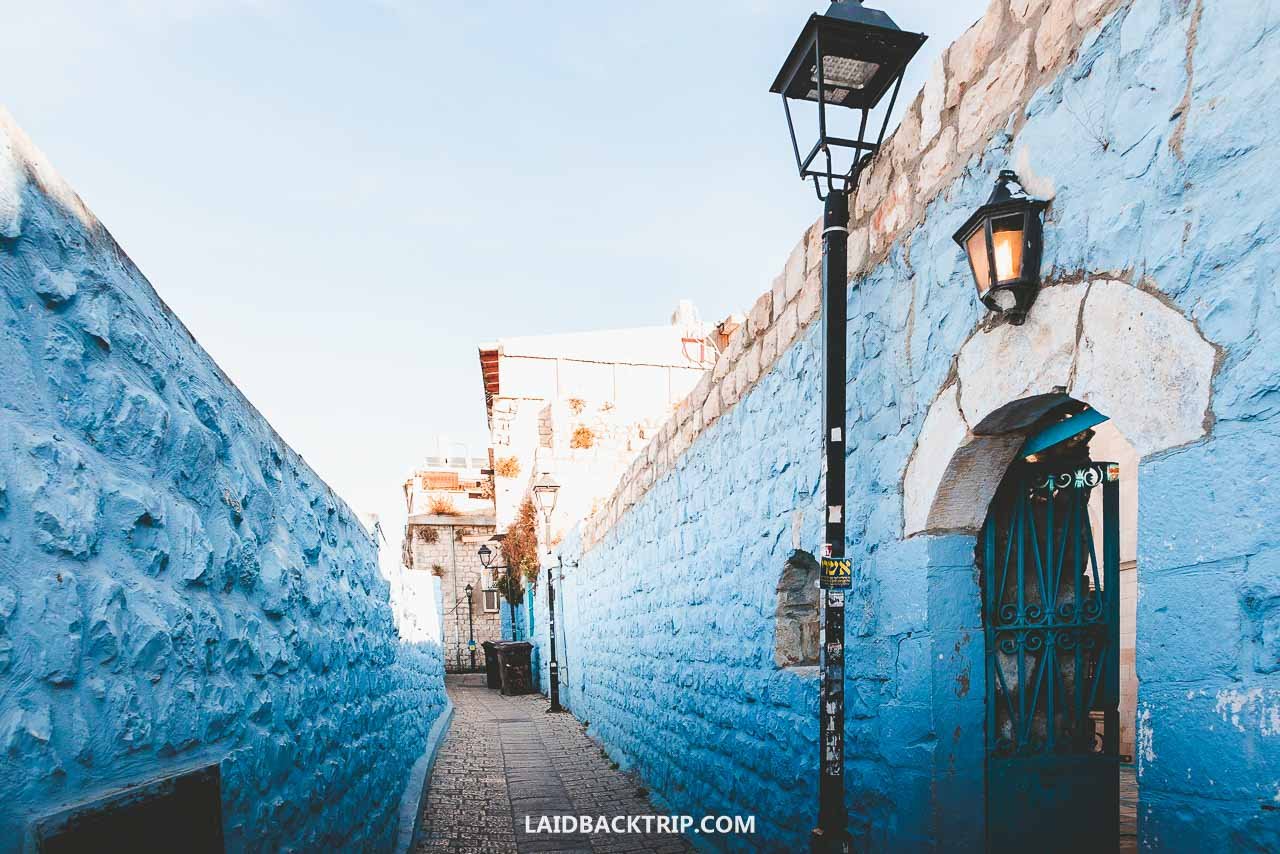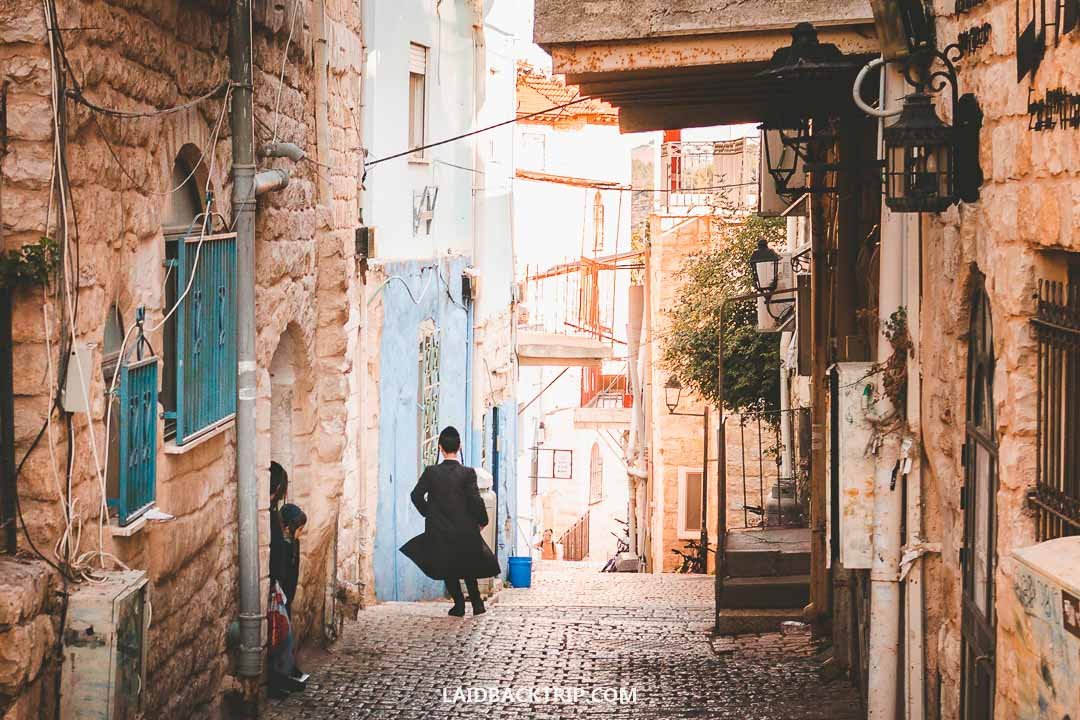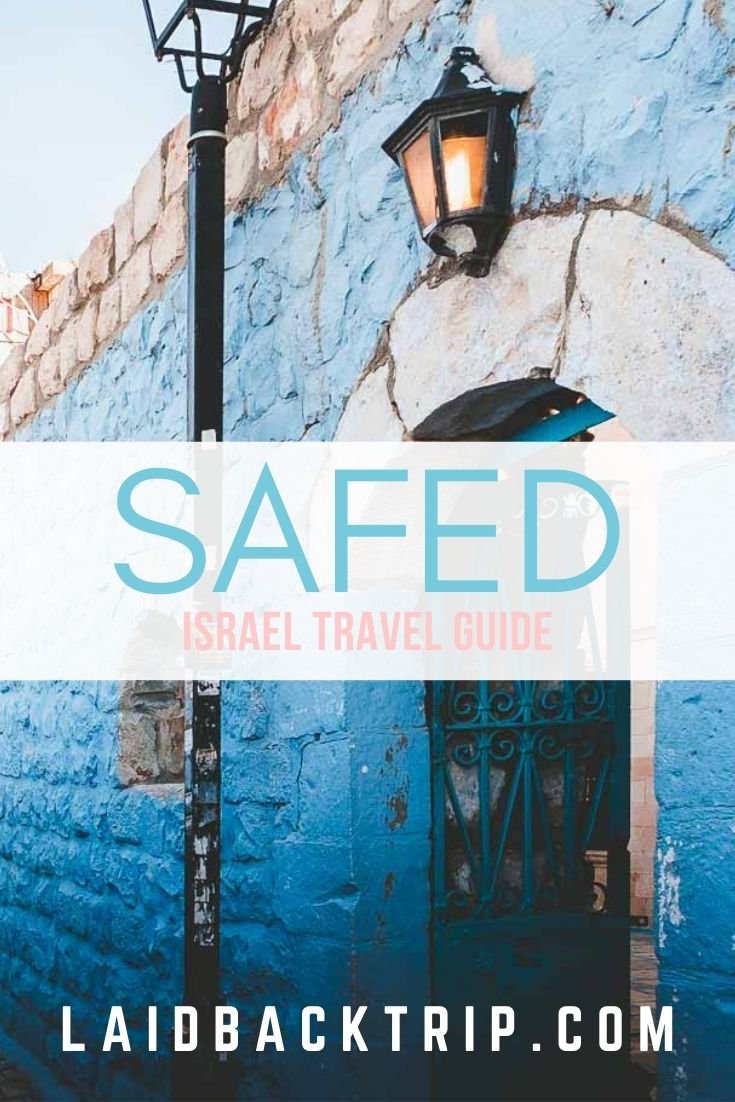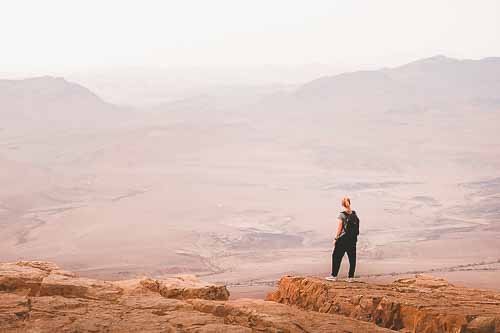A Guide to Safed in Israel
Read our travel guide on Safed (Tsfat) Israel. Includes best things to do and see, tips on where to stay, how to get, or when to go.
Located in the mountains of Galilee in Northern Israel, Safed is a city that can take you by surprise.
The city sits at an elevation of 800 meters above sea level and offers a very different experience from places such as the Sea of Galilee that you can find in the lower part of this region.
For starters, Safed is a significant city for Jewish people, one of the Four Holy Cities in Israel, and the center of Kabbalah.
It's also a place where Jewish mysticism hidden behind the blue-painted walls meets the vibrant art scene.
Does this combination of eclectic and ultra-Orthodox make any sense? We'll try to find out an answer to this burning question in this blog post.
Either way, Safed is an exciting city to visit. Moreover, it's a good place to see even if you're visiting Israel on a Budget.
So here's everything you need to know about Safed before you go.
Things to Know About Safed
Before visiting Safed, every visitor should know a few important things.
It's not like you can't go to the city without knowing them, but it can definitely make your visit more comfortable, especially if you are on a tight schedule.
Safed or Tsfat
Before we dive into the more practical side of this blog post, we should look what's the difference between these two names.
As you've probably guessed already, Tsfat is a Hebrew name for Safed.
By the way, these two names are not the only spelling versions, as you can come across names such as Tzfat, Zefat, Zfat, Safet, Safad, and more.
Safed is the English name for the city, and that's what we had called the city before our visit.
The critical thing to know is that the locals use Tsfat, and the pronunciation reflects that.
This can make your life a bit easier when the locals ask you if you've been to Tsfat or planning on going there as the names sound pretty different.
Safed on Shabbat
As mentioned above, Safed has an ultra-Orthodox community, so the timing of your visit is essential here.
We arrived in Safed on a Shabbat early in the morning, and the city was tranquil.
Some might even say that it was completely dead, but we sort of didn't mind the empty streets and peaceful atmosphere.
Due to the nature of our Israel itinerary, we couldn't find any workaround to this issue.
However, we said to ourselves that it might be an interesting experience to see the city while everyone's gone.
And it certainly felt different from what we could hear and read about Safed before our trip to Israel.
Still, we could see locals quietly roaming the streets, lost in their thoughts, or kids peeking from their doorways into the streets.
To some degree, it seemed like the perfect time to be there.
However, if you prefer the regular (more lively) Safed experience, then we would arrive here any time except Friday afternoon and Saturday.
Kabbalah in Safed
Safed is also known as the City of Kabbalah, and this mystical religious tradition that explains the spirituality of life is one of the main reasons to visit the city.
As the history of Jewish mysticism in Safed reaches back to the 16th century, you won't be the first visitors who want to know what Kaballah is, its history, or the mystic doctrines.
In this regard, Safed can take care of your curious mind as not any other place in Israel.
If you're really interested in Jewish mysticism and spiritualism (or Safed's history), you might want to consider hiring a local guide to get a peek under the hood.
While Kabbalah is what makes Safed stand out, you might not be interested in any of this, and that's perfectly fine, as you can enjoy the city without it.
One of the things we love the most about traveling is the opportunity to learn about new things every day.
Therefore, visiting places such as Safed that allow us to learn about things we don't know much about is always a fascinating experience.
Best Things to Do in Safed
So what is there to see and do in Safed?
From roaming its narrow streets, learning about Kabbalah, admiring and purchasing the local art, trying delicious Israeli cuisine to enjoying the scenic views of the Golan, Hermon, and Galilee, Safed has it all.
Safed Citadel
Once one of the largest fortresses in the Holy Land, Safed Citadel was the place where our steps led us first.
Due to its strategic location, the fortress played a vital role for whoever ruled the area, whether it was Mamluks, Romans, or early Jewish Kingdoms.
The citadel reached its peak during the Crusader era in the 12th century.
Unfortunately, a massive earthquake in 1837 destroyed a large portion of Safed, together with the fortress, and the strong walls and structures didn't survive to this day in their full glory.
It's a bit of shame that it's all gone because the Karak Castle we visited last year in Jordan was one of the highlights of our trip.
Today, the Safed Citadel is a large park with a few remaining ruins and a monument commemorating the Arab Israel War in 1948 (also known as Israel's War of Independence) in the south, a few trails, and a dirty concrete bunker in the north.
Even though there is not much left from the fortress, it's still a place you shouldn't skip, as the 360-degrees views from the top are simply breathtaking.
By the way, if you're interested in Crusader history, then don't forget to visit the incredible Hospitaller Fortress in Akko.
Old City
Walking the narrow streets of Safed's Old City is one of the best things to do while there. The Old City is only a few steps from the Safed Citadel, so that's where we headed next.
As we spent a few days before visiting Safed in the modern cities such as Tel Aviv or Haifa, the cobblestone winding streets together with the synagogues, little stores, and the ubiquitous mysticism were like stepping into a different world.
By the way, if art is not exactly your thing, Safed also has Kadosh Dairy or Hameiri Dairy, where you can buy delicious hand-made cheese, or Safed Candles, where you can buy, well, candles.
The City of Art or Kabballah is not the only two nicknames Safed can have. The streets painted in blue that match the sky's color can instantly make Safed the Blue City.
And while it might be tempting to use the map to avoid getting lost, doing the exact opposite might deliver a far more rewarding experience.
The chances are that you will get lost either way, so why not embrace the experience and get the most of it.
The small restaurants serving fantastic local food, old synagogues, together with countless art and souvenir stores, the fascinating history of Safed can be found in this serene quarter.
Maybe it was just our impression, but Safed's Old Town still felt like the neighborhood where the locals still live their daily lives despite the tourists (or together with tourists).
And we believe it's more than enough.
Synagogues Quarter
The Old City of Safed is full of old synagogues, and it's only a matter of time before you stumble upon one even without using the map.
When the Jews were expelled from Spain at the end of the 15th century, many of them moved to Safed.
The town full of mysticism and the opportunity to search for the divine was hard to resist.
Many synagogues were built around the city throughout the centuries, and if you get the chance to step in, don't miss it out.
Expect beautifully decorated interiors with the elevated podium in the middle and books everywhere you look.
That's not all, as some of the places have hundred years old Torah scrolls that are still in use.
There is no entrance fee to the synagogue, but you can make a small donation while there.
By the way, the donations boxes are pretty much all over the Old City. You can see them not only inside or outside the synagogues but even on the front doors of regular houses.
Earlier, we mentioned that Shabbat is not the best time to visit Safed, but we should also say that it might be a perfect time to visit one of the synagogues here, especially if you're Jewish.
And what are the best synagogues in Safed?
Rabbi Joseph Caro Synagogue, Abuhav Synagogue, Alshich Synagogue, Ari Sephardi, and Ari Ashkenazi are probably the most famous ones.
Depending on your arrival time, some places can have regular services or can be closed. For example, we could enter the Abuhav Synagogue, but Joseph Caro Synagogue was closed.
Artist Colony
It would not be fair to name Safed only as the City of Kabbalah, as it's also known as the City of Art. The Artist Quarter in Safed is one of the coolest places in Israel.
The spirituality and mysticism attracted many artists who moved here as early as the 1940s and 1950s and started their new chapter in their lives here in Safed.
The State of Israel even created an incentive program for young artists in order to encourage them to move to Safed.
That's an indeed interesting idea, that brought some exciting results.
A lot of artists are practicing Jews, and their religion, together with other aspects of their life reflects in their work.
Therefore, Safed is, together with Jerusalem, one of the best places to buy Judaica in Israel.
You can find here anything from studios with artists creating and selling their own art to studios dedicated to a famous artist.
Discovering the art that you like the most is the biggest fun of your visit to the Artist Quarter.
Therefore, we would probably not google what are the best galleries in Safed before the trip unless you have some particular items on your wish list, of course.
Keep in mind that the art galleries are usually open from 10 AM to 5 PM every day except for the Shabbat. As we learned ourselves, everything is closed on Saturday.
Therefore, if you want to purchase some art, don't visit Safed on this day.
Best Day Trips From Safed
Safed has a strategic location in Northern Israel, and it might make sense for travelers to base themselves there for a day or two.
So what points of interest lie near Safed?
Rosh Pinna
We can't start this list with anything else than Rosh Pinna, a small town about a 20-minute drive from Safed.
Rosh Pinna is known for its laidback atmosphere, old stone houses, lovely scenery, superb accommodations, and nearby wineries.
If you're looking for almost a European experience in Israel, you won't find much better places than Rosh Pinna.
And if you find Safed too hectic, then you can consider staying in Rosh Pinna instead and visiting Safed from there.
To make sure you will have everything you need, places such as Bayit Bagalil Boutique Hotel or Boutique Hotel Tamarin offer one of the best lodging experiences in Israel, though it will be an expensive night(s).
Sea of Galilee
Maybe you've just arrived from the Sea of Galilee, or perhaps you're heading there next; the point is that this area full of Biblical sites should be on your Israel itinerary.
There is not a better place in Israel to follow Jesus's footsteps than the area surrounding this massive low-altitude freshwater lake.
Christian pilgrims flock to the Sea of Galilee for apparent reasons, but you don't need to be religious to enjoy the area.
Tiberias is a popular summer destination for locals, Capernaum is the hometown of Jesus, where he did his ministry and miracles, and Nazareth is an exciting mix of an Arab and Christian city.
You can find more places such as Tabgha, Mount Beatitudes, or Kursi National Park here, so make sure to get the most of this area.
The entire Lower Galilee region suffers from extremely high temperatures in summer, so Safed might be a great place to find a hideout from the unforgiving heat.
Northern Israel
The northeast part of the Northern District is for sure not short of exciting places, and the fewer crowds can make it a fantastic alternative to Israel's more famous locations, such as the Dead Sea area.
Kiryat Shmona, Tel Dan Nature Reserve, Hula Nature Reserve, Banias Falls, and Nimrod Fortress are a few places worth visiting in this mountainous area.
Make sure to bring your Israel Pass with you.
Tel Hazor National Park
One of the less-visited national parks in Israel, Tel Hazor, is one of those places that not many international travelers visit during their trip to the Holy Land.
Quite frankly, Tel Hazor is not as spectacular as its far more famous counterparts, such as Beit Shean or Caesarea, but we do have a soft spot for this national park.
The former glory of this place can be seen only in the scattered and badly damaged structures and few informative boards.
However, Tel Hazor has a huge water cistern accessible by a 40-meter shaft with a spiral metal staircase, which is not something you find (almost) even in places such as Masada or Avdat National Park.
Tel Hazor is one of those places where having a guide is an advantage.
How to Get There
Driving in Israel didn't cause us any problems, and we were pleasantly surprised how everything went so smoothly.
Moreover, we quickly found that having a car was the best way to get around Israel.
Safed is well-connected with the rest of the country so arriving there by public transport is pretty easy if you don't want to rent a car in Israel.
However, you will lose the flexibility to explore the country at your own pace.
Additionally, you will struggle to create a sensible travel itinerary if you want to visit multiple sites or towns in one day.
Car
From Tiberias, take Highway 90 and then turn onto Highway 89. Follow the road until you reach Safed. The journey should take about 45 minutes.
Nazareth is 60 kilometers southwest of Safed, and it takes between an hour and an hour and a half to get there.
There are several routes you can choose from when traveling to Safed from Haifa, so pick the one that's fastest according to your navigation's live traffic data.
Akko lies in the west of Safed, and travelers usually take Highway 85 to travel between these two cities.
Alternatively, you can take Highway 89, depending on the traffic. It should take you no longer than an hour and a half to get from one place to another.
When traveling to Safed from Jerusalem or Tel Aviv, allow yourself about three hours, and note that Highway 6 has a toll.
Here you can find the best deals on rental cars in Israel.
Bus
Bus 982 and 992 is direct bus between Jerusalem and Safed (3 hours).
Egged company has a bus 846 between Tel Aviv and Safed that runs once a day.
A bus 450 by Superbus departs every forty minutes from Tiberias Central Bus Station, and the ride to Safed Central Bus Station takes less than thirty minutes.
Tours
Alternatively, consider taking this highly customizable private Nazareth and Galilee Guided Tour that departs from Tel Aviv, Jerusalem, Haifa, and other places in Northern Israel.
Parking
Parking can be problematic in Israel regardless of the location. We found free parking in Safed in front of the Saraya.
This is a fairly large parking lot, and as we arrived there early in the morning, there was plenty of space.
Saraya is less than ten minutes' walk from Safed's city center. This central location is excellent, and it seems that you won't find a much more convenient parking lot than this one.
You can also try to leave your car on the busy Jerusalem Street, but it's not free.
Paying is usually possible at the parking meter or through a mobile app (Pango is popular).
We've also seen parking spaces under the Safed Citadel (HaMetsuda Garden), but once again, not all of them were free.
When to Go
Due to the elevation, Safed is colder than the Sea of Galilee area, and even the hot summers this region sees every year are more bearable here.
Not that it's not hot in Safed on a clear summer day, but the cool breeze usually takes care of the high temperatures and brings them down to tolerable levels.
Still, we believe that the best time to visit Safed is spring or autumn. Expect mild weather and fewer crowds during this period.
Winter is surprisingly cold and humid in Safed, at least compared to towns in southern areas and lower elevations.
It's also a period when it can rain here. Occasionally, Safed even gets some snow.
For more infomration on this topic, read our guide on when to visit Israel.
What to Wear
Don't forget that Safed's city center has a strong Jewish ultra-Orthodox community, and you should wear modest clothing while there.
On top of that, bring a good daypack, comfy runners, and a water bottle.
Summers are hot in Safed, so stay hydrated throughout the day.
If you're visiting Safed in winter, make sure to bring an extra warm layer or even a rain jacket.
We usually take a down jacket when we're not sure what to bring with us. It's very light and compact and solves all the 'staying warm' issues.
The weather in spring and autumn can go either way, so we would be prepared for both warm and cold conditions.
Where to Stay
When it comes to searching for accommodation in Safed, you have basically three options. Stay in the Safed's Old Town, in the Artist Colony, or some quiet location away from the city center.
Each area has its pros and cons, so pick the one that suits your travel preferences.
The general rule of thumb is that the areas farther from the city require either a car or flexibility to travel by public transport, while the centrally located areas are not as peaceful.
Here's our choice of the best hotels in Safed.
Budget | Safed Inn - One of the best budget hostels in Tsfat, Safed Inn offers air-conditioned private rooms and dormitories, free Wi-Fi, a shared kitchen, and lovely grounds. The hostel has a quiet location outside the city center, and there's a bus stop directly across the street if you don't have a car.
Mid-range | The Way Inn Boutique Suites - Situated in the Artist's Colony, The Way Inn Boutique Suites boasts private rooms with lovely decor and comfortable beds, a sun terrace with splendid views, and a delicious breakfast.
Luxury | Villa Galilee Boutique Hotel and Spa - Located on Mount Canaan in a peaceful location only a few minutes' drive from the city center, Villa Galilee Boutique Hotel and Spa offers stylish rooms, a seasonal outdoor swimming pool, and a spa center with massage treatments.
Staying Safe
Safed is often regarded as most of the other Israeli tourist destinations as safe to visit.
We felt perfectly safe there and didn't run into any problems. Some parts of Safed's Old Town might seem to be a bit neglected, but that might change in the future.
As mentioned earlier, make sure to wear modest clothing to respect the local community living there and prevent any unnecessary situations.
Despite the fact that the security is good in Safed, you should still exercise caution and use common sense to stay safe in Israel wherever you travel.
Travel Insurance
We never leave home without travel insurance that was designed to cover our expenses if something goes wrong during the trip.
Travel insurance protects against theft, flight delays, injury, illness, cancellations, and much more.
World Nomads provides travel insurance for travelers to cover their trip essentials, including sports and adventure activities.
SafetyWing is affordable travel insurance for backpackers, long-term travelers, and digital nomads.
Travel smarter and safer!
Is Safed Worth Visiting?
Safed is a popular travel destination, and we believe it's worth a visit if you have spare time to fill in.
Is it a must-visit place in Israel? Well, that's a hard one.
In our opinion, the entire Galilee region should be on your travel itinerary, but there are so many places to see in Israel that it's not easy to pick the ones you should visit if time is not on your side.
Safed is definitely one of the most interesting ones. The question is if the town can keep you entertained for the entire time of your visit.
The Old Town is relatively small, and if you're not particularly observant, or not taking things slowly, you can see everything in like an hour or two.
And that might seem as not enough for someone visiting Safed, let's say, on a day trip from Tel Aviv.
On the other hand, some people might stay here a day or two and still won't get enough of Safed. Knowing what to expect is essential to have a better trip.
So let us know what you think of Safed in the comments below.
Travel Resources
Here you can find links to all the travel resources we use and which you might find helpful when planning your next holiday.
Accommodation: When looking for accommodation, we usually search hotels via Booking.com or Hostelworld.
Tours: Although we love to travel independently, some places are better to visit with a guided tour.
We prefer GetYourGuide for its easy-to-use interface and solid reputation. Another great alternative is Viator.
Rental Cars: When going on a road trip, we always use Rentalcars.com, a reliable site for booking a rental car in advance.
Flight Tickets: When looking for flight tickets, you can search Skyscanner to find the best price.
Travel Insurance: World Nomads and SafetyWing cover against risks of travel.















